
Welcome to Hip Harp Academy Member Spotlight Series: Power of Pattern Quarter (Part 1 of 3)
For this year’s third quarter, Hip Harp Academy Members poured out their creativity to the next level, putting their creative expression into forms so that they can share it with others. And now, I’m sharing them with you!
Scroll down to see the projects – but first, take a moment to think about the power of people sharing their creative PROCESS instead of a PERFECTED “PRESENTATION.” What you’ll learn from these videos – and the mini-interviews in which they share their process – will be far more inspiring to your creativity than someone sharing a trendy video with five gazillion hits. This is creative process – and in these shares, you get to glimpse into the process of other people like you and HOW they overcame their own blocks to accomplish their next creative goal.
The Hip Harp Academy Members’ Final Beginning Project
How to enjoy these wonderful video shares: Enjoy the creativity and the willingness to share. Think about the fact that each of these videos is a unique creation – none of these musicians are playing written sheet music – they’ve created these arrangements by learning the fundamentals of arrangement and improvisation and putting them into play – literally – in their own creations. And notice how different each video and each project is from the others … and yet they were all taking the exact same class.
This is the power of learning the tools of self-expression and creativity.
“Final-Beginning” is a term we use remind ourselves that these are not meant to be “Final” projects. If we worry about making them ‘FINAL’, we’d never share! Instead, we learn to embody a moment of completion as a new beginning: to acknowledge an accomplishment as something that opens up a new door, a new place to stand in, a new level of confidence – not the FINAL – it’s not the END … but the new BEGINNING.
So think about that as you watch them and read their own account of their personal creative journey in creating each video by clicking the toggle beneath each video – and I encourage you to do that if you really want to be inspired.
Some of the players have played for years, and even decades – some have come to the harp as adults – some even as a retirement gift for themselves. We’re a community connected by a commitment to creative expression. Every week we meet for masterclasses and training, and during the week we practice the new ideas and the willingness to be vulnerable, authentic and self-expressed with our instruments, our voices and ourSELVES.
So be inspired by that commitment, let it infuse your own life – and if you play the harp, come join us at Hip Harp Academy.
Harpists Who Dare!
Are you ready to free yourself from the notes on the page?
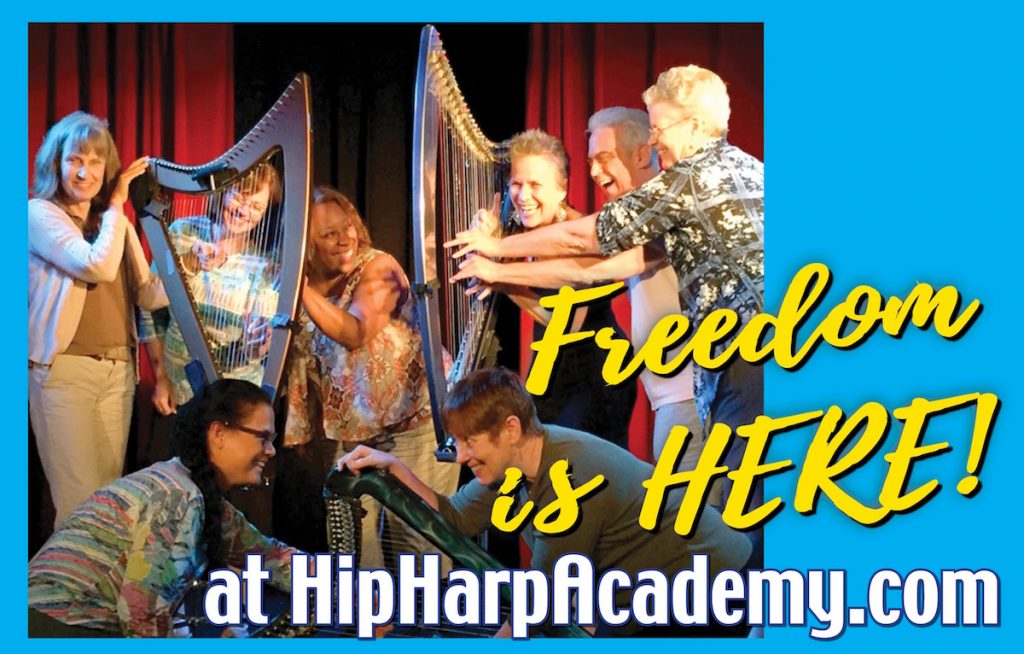
Cherrie Mooney:
I’ve never played with a bass or drums before and didn’t know what to expect. They never played with a harp so it was a new experience for all of us. We all enjoyed experimenting.
Cherrie's Insights about this Project
Describe your final project so I know exactly what you’re sending me.
This is a slow blues tune played with a bass and drums. There’s an intro, 3 sets of 12-bar blues chords, the second being a bass solo, and an ending. There’s two extra measures in between each 12-bar set.
What principles from this course or from chats did you use to develop, perform, and record this project – and how did they play a part in your process?
I combined different blues patterns and ideas to develop a blues tune, using slap bass, the 12-bar blues chords, and a swing feel.
Give a short description of what it took for you to be able to play what you did – both logistically and emotionally.
I needed to be sure of myself when I practiced with the group. I felt comfortable telling them what I needed from them and we worked well together.
What freedoms and blocks within yourself did you connect with (or struggle with) in the process?
I’ve never played with a bass or drums before and didn’t know what to expect. They never played with a harp so it was a new experience for all of us. We all enjoyed experimenting.
What challenges did you meet while connecting with your own freedom of expression in this project?
It was a challenge for me to step out of my comfort zone and ask others to join me.
What other parts of your life were impacted by what you learned in this class, and how?
As time goes on, with participating in class, doing homework and the projects, I have become more confident and now have a “can do” attitude with others challenges in my life.
What were your personal “Ahas”?
Thinking and acting outside of the box can be rewarding.
Is there anything else you want people to know when they watch your video?
I thoroughly enjoyed doing this!
Laurie:
One major block within myself to put my playing out there for others. The power of the patterns also opened up the possibility of tackling this piece section by section, pattern by pattern.
Laurie's Insights about this Project
Describe your final project so I know exactly what you’re sending me.
This is for Power of Pattern (not a choice above).This is Nataliana. I still shy away from posting, and decided to just do it.
Describe your written materials – if there’s anything in particular you want to say about it to help people know what they’re looking at, add that here.
My version of Nataliana is very slow, and not yet totally in my fingers. But I love that the power of pattern really allowed me to learn it. I’d like feedback on the tempo. I think it needs to be picked up a little – that it’s too slow. That an audience might find it dragging. (I don’t yet play for an audience, 😉 ) Also, I’ve taken many liberties in rhythm, to express musicality. What works and what could be improved upon? Thank you!
What principles from this course or from chats did you use to develop, perform, and record this project – and how did they play a part in your process?
The power of pattern – finding all the patterns and understanding the piece made it accessible to me. I had held onto this piece for years – because of overwhelm and doubt – before actually being able to break it down and playing it through your course.
Give a short description of what it took for you to be able to play what you did – both logistically and emotionally.
I needed to work on a lot of technique – and still need to improve on that technique to play with flow and expression. Particularly, the right hand downward triplet pattern in what I’ve labeled as section E; as well as the downward arpeggio pattern just before the ending section of the piece.
What freedoms and blocks within yourself did you connect with (or struggle with) in the process?
Major block within myself to put my playing out there for others. The power of the patterns also opened up the possibility of tackling this piece section by section, pattern by pattern.
What challenges did you meet while connecting with your own freedom of expression in this project?
For me, this is a very emotional piece that immediately touched me. Technique issues were the biggest factor interfering with what I wanted to express in my playing.
What other parts of your life were impacted by what you learned in this class, and how?
Will think about this…..
What were your personal “Ahas”?
All mentioned above……
Harpists Who Dare!
Are you ready to free yourself from the notes on the page?

Elizabeth Owens:
I don’t like this video…And I know that this is exactly why I’m posting this. Maybe I will record another, but as of now, I’m letting myself fail really hard…for myself. This is a gift to myself that you all give me the strength to give, simply by being here and by being you.
Elizabeth's Insights about this Project
Describe your final project so I know exactly what you’re sending me.
This is a “failed” attempt to record in some fashion what has turned out to be the most humbling song I’ve ever tried to write. It’s a video of me blindly fumbling to sing a song while it’s being created. It’s a leap of faith and an honest effort to connect with a part of myself that has been crying to heard for the past year and a half.
I will…hopefully record another more completed version this week. But this was a necessary start!
What principles from this course or from chats did you use to develop, perform, and record this project – and how did they play a part in your process?
Flexibility. Simplicity. Openness. Stillness. Touch. Connection. Reconnection. Listening. Seeing. Failing, falling, crawling…and sharing it with the world. Reconnection.
These practices and principles have allowed me to reconnect with myself through this song and commit to creating the space for that.
Give a short description of what it took for you to be able to play what you did – both logistically and emotionally.
Both logistically and emotionally, this project forced me to surrender. Surrender my need for the perfect shot. for the right notes. for the best voicings. for the best vocal take. for well mixed audio. One of the most challenging musical/arts experience I’ve had.
What freedoms and blocks within yourself did you connect with (or struggle with) in the process?
This is the last song on an album I’ve been working on for close to 3 years. While all the other songs have poured out of me organically (they usually do), I felt a lot of resistance with this one for some reason. It was hard to follow… hard to know or understand how to end it. I realized through singing her over and over again, spending enough time with her to /really/ pay attention (which I wouldn’t have done without these program holding me accountable), I could finally hear her message – the antidote to my block: “Hear me”.
The last 3 months have been traumatic for me, and even before that I was having such a hard time connecting with my music…committing to my spirit in that form, specifically. Which I know is the most natural and healing form….
Every single line from every single song I’ve written the last 4 years points to the same message: stop trying so hard. My subconscious wants me to hear this SO BADLY that s/he has spelled it out in every possible way she can and still….I forget so easily.
The completion of this song – or at least the feeling of wholeness and sense of connection I now have with it – has shifted something into place. I remember now. I remember.
What challenges did you meet while connecting with your own freedom of expression in this project?
I make things too complicated. Everything you can think of. Things I didn’t even know could be made complicated. So obviously I overwrote and overwrote and rewrote and rearranged and replayed and restructured and revoiced the second verse of this song until I couldn’t take it anymore… I let it fall away and played blind.
What other parts of your life were impacted by what you learned in this class, and how?
WOW what an easy simple question to answer! haha.
I will just say that since meeting DHC and being surrounded by such a wonderful community at the JPG confab, I feel transformed in a way I didn’t know I could. The reconnection to values like flexibility, vulnerability, letting go…I needed those this year more than I ever have. Fate.
What were your personal “Ahas”?
See above
Is there anything else you want people to know when they watch your video?
I don’t like this this video. I don’t like this performance…I don’t like that you all can’t see all of the beauty and soul and eloquence that came out of me before I started recording. I don’t like that my vocals are only in the left channel and that they aren’t as powerful and smooth as they are when at my best. I don’t like that it’s not even close to what I know the final recording will sound like (as if I know…). I just don’t like that you can see my flaws and my stumbling and I feel like I need to convince you that I really /am/ good at this instrument and at singing, I promise!!!
And I know that this is exactly why I’m posting this. Maybe I will record another, but as of now, I’m letting myself fail really hard…for myself. This is a gift to myself that you all give me the strength to give, simply by being here and by being you.
Cherie Maffey:
I had looked at trying to play this tune about 3 years ago but didn’t get very far. Learning the patterns has made it easier to play and remember.
Cherie's Insights about this Project
Describe your final project so I know exactly what you’re sending me.
I’m playing a rhythmic, repeating pattern for the tune “In the Mood.” This is a tune I loved as a child and would dance around the house when my big brother played this on the piano.
What principles from this course or from chats did you use to develop, perform, and record this project – and how did they play a part in your process?
Using the dominant for an introduction, in this case I’m in the key of C and so built up a pattern on G. Learning rhythms in the SHJ and during class and recognising repeated patterns made this possible. This is my favourite quarter as I enjoy learning rhythms.
Give a short description of what it took for you to be able to play what you did – both logistically and emotionally.
Patterns, they have always been there but I couldn’t see them without learning the skills in this quarter.
What freedoms and blocks within yourself did you connect with (or struggle with) in the process?
I had looked at trying to play this tune about 3 years ago but didn’t get very far. Learning the patterns has made it easier to play and remember.
What challenges did you meet while connecting with your own freedom of expression in this project?
I could hear the tune in my head from when I was a child and then playing it on the harp was the challenge. I’ve used many ideas from the classes, including a section I learnt in the SHJ.
What other parts of your life were impacted by what you learned in this class, and how?
If you really love something, just have a go. I was surprised that I could actually play this tune and how much fun it is to play.
What were your personal “Ahas”?
Recognising patterns in music and how they repeat. I’ve just never seen it so clearly before. Then being able to apply the skills from this quarter to a piece of music that I love from my childhood.
Is there anything else you want people to know when they watch your video?
I love playing this tune and it makes me feel energised when I play it, no matter how down I might feel, it lifts my spirits.
Harpists Who Dare!
Are you ready to free yourself from the notes on the page?

Lynne Lapidus:
Sometimes I think the songs are already there, I’m not writing them, I’m “catching” them and learning to play them.
Lynne's Insights about this Project
Describe your final project so I know exactly what you’re sending me.
This is the second half of a song I’ve been working on all quarter. The whole song is too long for the project, and many have seen the first 2 verses already. I know we aren’t supposed to solicit feedback on Final Beginnings, but I’m really curious about something and would love your opinions: Reminder: the first verse was a baby being picked up and touched for the first time. The second verse was two children clinging to each other frightened in a storm. The playing was rubato and I started this video with the two main chords how they were used in those verses. Then I played the end of the chorus “The Human Touch”. The third verse (first in this video) is from when I met my husband. I play this much more rhythmically because it is happy. Then I slow down and use more altered chords and various arpeggiations for the final verse which is about my father and sing the last chorus in that same style. The question is: what do you think about ending the song in this style? Should I leave that sad verse out so that it is a more positive song all in one basic style? It does get very long because it is so wordy and can’t really be sung too fast…. What do you think? The four stories were planned from the start, but I didn’t know how the music would end up…Thank you!
What principles from this course or from chats did you use to develop, perform, and record this project – and how did they play a part in your process?
So many skills from the Academy! Let’s see, for this I used: Altered dominant chord, rhythm (and NO comping rhythm), blues scale improv that became the melody, playing a tag that is three times turnaround at the end
Give a short description of what it took for you to be able to play what you did – both logistically and emotionally.
Well, being that it is a lifecycle story, I had to revisit my father’s death as I was writing and learning to sing it. The lyrics would come at odd times and I’d review them before bed to solidify them, which was sad for the final verse. It reminded me of hearing my father crying himself to sleep after my mother died. Which also made me crying myself to sleep all these years later.
What freedoms and blocks within yourself did you connect with (or struggle with) in the process?
I was blocking myself by trying to force the song in a different direction than it wanted to go.
What challenges did you meet while connecting with your own freedom of expression in this project?
HAH! This song was in my head so much that I couldn’t work on learning songs for my chorus! (shhh-don’t tell them)
What other parts of your life were impacted by what you learned in this class, and how?
Sometimes I think the songs are already there, I’m not writing them, I’m “catching” them and learning to play them….
What were your personal “Ahas”?
I’m learning to take more time for myself.
Is there anything else you want people to know when they watch your video?
This is the second half of a song I’ve been working on all quarter. The whole song is too long for the project, and many of you have seen the first 2 verses already. : Reminder: the first verse was a baby being picked up and touched for the first time. The second verse was two children clinging to each other frightened in a storm. The playing was rubato and I started this video with the two main chords how they were used in those verses. Then I played the end of the chorus “The Human Touch”. The third verse (first in this video) is from when I met my husband. I play this much more rhythmically because it is happy. Then I slow down and use more altered chords and various arpeggiations for the final verse which is about my father and sing the last chorus in that same style.
JD:
I think perseverance in focusing on what is hard for the moment even though it’s not perfect will eventually provide a new skill for other situations.
JD's Insights about this Project
Describe your final project so I know exactly what you’re sending me.
This is my Alaska Bear Blues in D using the slap bass.
What principles from this course or from chats did you use to develop, perform, and record this project – and how did they play a part in your process?
The slap bass is what I focused on learning. First to get the rhythm with the left hand and then adding in the right hand. Next was to change chords and keep the rhythm. Then the doing vamp for one of the choruses, and then add a chorus with different notes. The final thing that I added was to sing while playing this.
Give a short description of what it took for you to be able to play what you did – both logistically and emotionally.
Going out of my comfort zone and perseverance to get that slap bass.
What freedoms and blocks within yourself did you connect with (or struggle with) in the process?
My downfall is rhythm. This took a bit to get with the left hand and then add the metronome right hand. I worked with the homework for the chats and Sally for the catchup coaching and observed others and the input from their homework to improve.
What challenges did you meet while connecting with your own freedom of expression in this project?
I started out with the 12 bar Alaska Bear Blues for the pictogram for the first assignment as kind of a chortle. Then after the next two lessons and working on the slap bass I was freaking out as to what I would do for my project. Then I thought why not go back to my pictogram and use the idea for my project.
What other parts of your life were impacted by what you learned in this class, and how?
I think perseverance in focusing on what is hard for the moment even though it’s not perfect will eventually provide a new skill for other situations.
What were your personal “Ahas”?
Practice to let me get the groove and coordination and then having fun with how to use it.
Is there anything else you want people to know when they watch your video?
Just enjoy and let the grins and giggles take over.
Joke Verdoold:
It not a perfect version! But I’m so happy that more and more I’m getting capable of masking (sometime huge) mistakes.
Joke's Insights about this Project
Describe your final project so I know exactly what you’re sending me.
My version of Gershwin’s Summertime. I thought up a lot of nice stuff to play and then started to leave more and more of it out, for the sake of fluency and tempo. I hope to play this on my performance coming Saturday, also if I now had to improvise to ‘mask’ mistakes. I like the beginning and the end best, but if you really must for the length, you can start it in at 1:05 missing the start, or play it till 3:19, missing the end.
What principles from this course or from chats did you use to develop, perform, and record this project – and how did they play a part in your process?
The power of pattern, repeating patterns, but in slightly different forms. That happened quite naturally, because I came bored with what I did.
Give a short description of what it took for you to be able to play what you did – both logistically and emotionally.
I needed to divide the song in pieces to be able to find harp parts that worked. It gets more and more difficult to concentrates on both singing and playing equally.
What freedoms and blocks within yourself did you connect with (or struggle with) in the process?
I took the freedom to not think about the chords, but just listen to what forms lay best in my hand and if I liked the sound of them. That took so much more time that I had a bad feeling about finishing and having enough time to get if fluently played.
What challenges did you meet while connecting with your own freedom of expression in this project?
The more I got it in my fingers the more my enthusiasm grew.
What other parts of your life were impacted by what you learned in this class, and how?
Let it go. Somewhere something will happen to give you the time you need.
What were your personal “Ahas”?
The moment I thought i had to speed things up and then it worked almost immediately..
Is there anything else you want people to know when they watch your video?
It not a perfect version! But also I’m so happy that more and more I’m getting capable of masking (sometime huge) mistakes.
Harpists Who Dare!
Are you ready to free yourself from the notes on the page?

PROJECTS & PERFORMANCES:
FOR HARPISTS:
- Join Hip Harp Academy
- Harp Time Live (FREE Weekly Playalong)
- FREE Resources

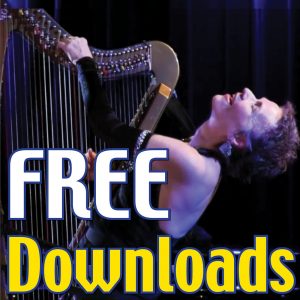
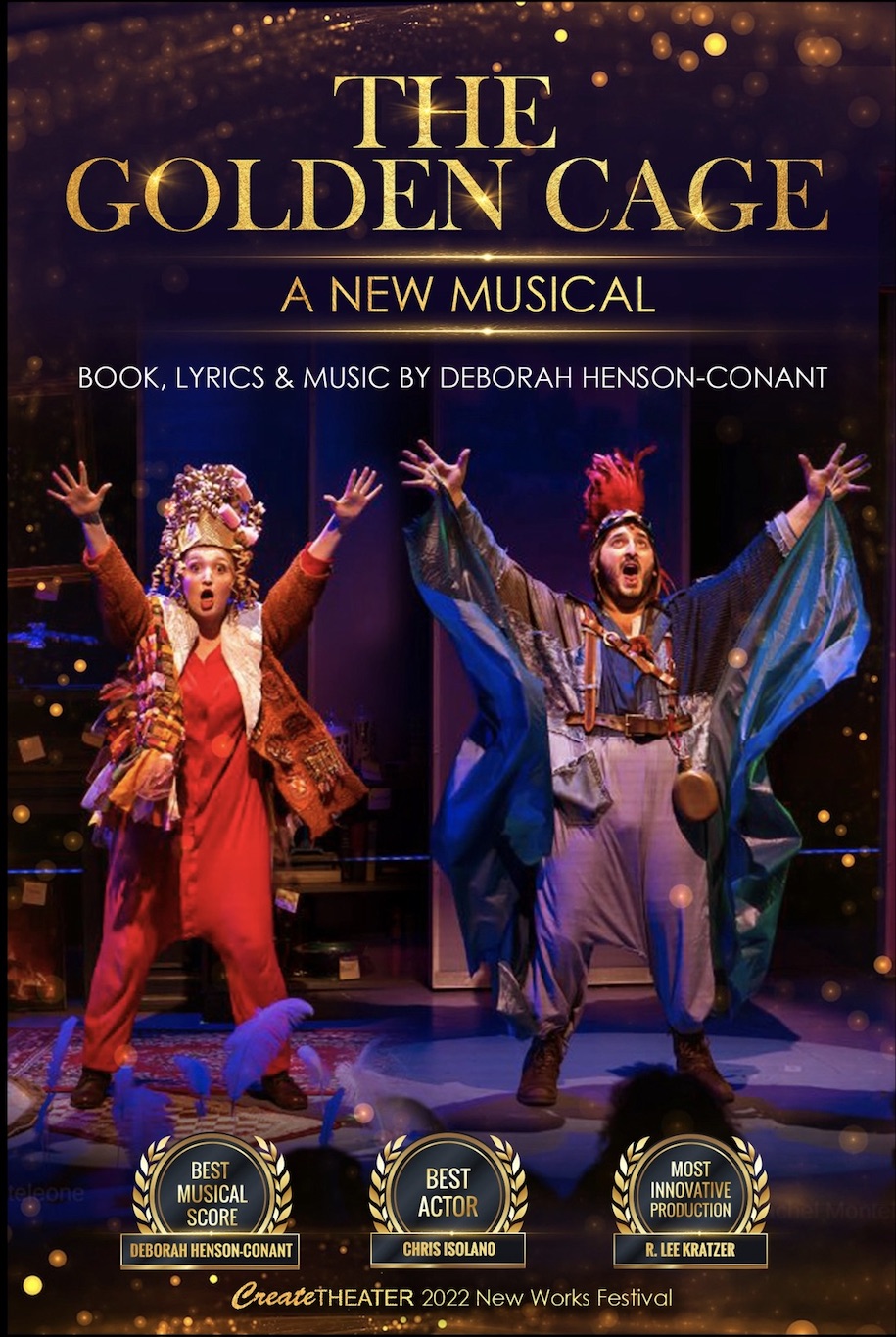
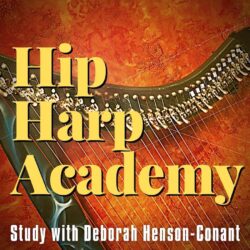
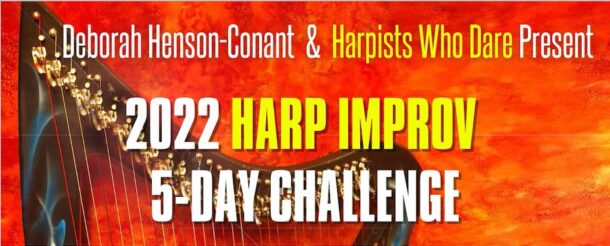
Join for Freebies, Stories & News
Join to get weekly-ish emails with stories, videos & events like concerts & classes
Yay! You should get my next newsletter within the next 7-10 days. I'm so happy we'll be in touch!
I won't ever share your email address with others - and you can unsubscribe anytime, tho most people say they really enjoy these weeklish emails.